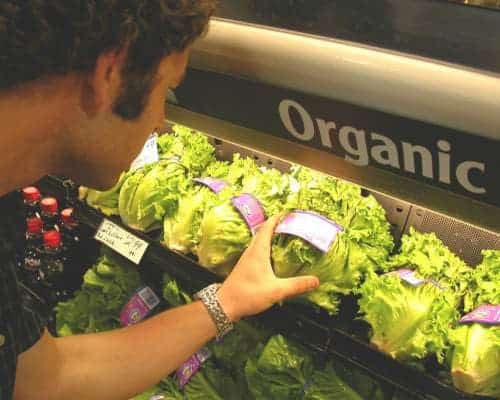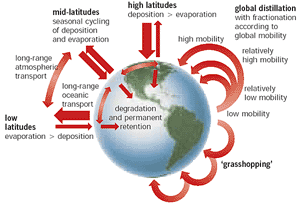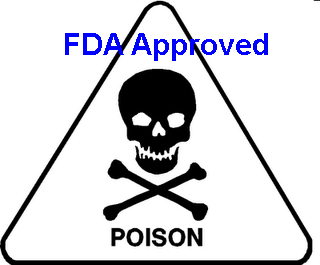
August 24, 2012
Mmmm, food. We all need it, we all love it, but what are we really ingesting on a daily basis? A recent study of ancient remains has found that cancer is a man-made disease fueled by the excesses of modern life, specifically the result of pollutants and poor diet. Could that be true? Coupling that potential revelation with a burgeoning series of events, including: massive egg and meat recalls due to salmonella and E. coli outbreaks; a recent study linking pesticides in food to autism and ADHD; the debate over labeling genetically modified foods and evidence showing the danger of GMOs; the success of food-production documentaries such as Food, Inc. and The Future of Food; and the heated debate on allowing the first genetically modified meat into the American food market, we thought it necessary to take a closer look at what goes into the cultivation and production of our foods and what that means to us.
I. Pesticides and other Persistent Organic Pollutants
A report released by the Pesticide Action Network (PAN) finds that Americans can experience up to 70 daily exposures to residues of a class of toxic chemicals known as "persistent organic pollutants" or POP's, including such lethal chemicals as dioxin and DDT, through their diets.
The report presents compelling evidence that organic foods are much less likely to have any toxic residues and that when organic foods do have residues they have fewer, with the levels of residues generally lower. Seventy-three percent of conventionally grown foods had residue from at least one pesticide and were 6-times as likely as organic foods to contain multiple pesticide residues. Only 23% of the organic samples of the same food groups had any pesticide residues. Also, to counter a popular misconception, washing the surface of these foods does not eliminate pesticide residues, as the poison remnants are within the tissue of the organism.
Sources of POPs include industrial chemicals, byproducts of manufacturing processes and waste incineration, as well as pesticides. The report, "Nowhere to Hide: Persistent Toxic Chemicals in the U.S. Food Supply," analyzes chemical residue data collected by the U.S. Food and Drug Administration (FDA) and finds persistent chemical contaminants in all food groups, from baked goods, to meats and fish, to fresh fruits and vegetables. Furthermore, POPs become increasingly concentrated as they move through the food chain. Instead of degrading, they build up and remain in the tissue of people, animals and other ecosystems for a long period. This bio-accumulation of toxic chemicals increases the risk for diseases such as cancer and also contributes to abnormalities in brain development and in the reproductive systems of animals and human beings.
The report states that exposure to POPs have been linked to serious disease and developmental disorders, including breast and other types of cancer; immune system suppression; nervous system disorders; attention deficit disorder; learning disabilities; reproductive damage; and disruption of hormonal systems. Developing fetuses and children are especially vulnerable to problems caused by exposure to POPs. Sources of POPs include industrial chemicals, byproducts of manufacturing processes and waste incineration, as well as pesticides. The report, "Nowhere to Hide: Persistent Toxic Chemicals in the U.S. Food Supply," analyzes chemical residue data collected by the U.S. Food and Drug Administration (FDA) and finds persistent chemical contaminants in all food groups, from baked goods, to meats and fish, to fresh fruits and vegetables. Furthermore, POPs become increasingly concentrated as they move through the food chain. Instead of degrading, they build up and remain in the tissue of people, animals and other ecosystems for a long period. This bio-accumulation of toxic chemicals increases the risk for diseases such as cancer and also contributes to abnormalities in brain development and in the reproductive systems of animals and human beings.
A study from Harvard University shows that even tiny, allowable amounts of a common pesticide class can have dramatic effects on brain chemistry. Organophosphate insecticides are among the most widely used pesticides in the U.S. and have long been known to be particularly toxic for children. Recent scientific studies show that exposure to even very small levels of such POPs at crucial times in fetal and infant development can disrupt or damage reproductive, neurological and immune systems. A recent report found that more than a fifth of the food eaten by two small sample groups of U.S. children was tainted with pesticides. Of the food containing pesticides, about one quarter contained more than one kind. All in all, the Environmental Health Perspectives study found 14 different varieties of pesticides in the conventional food samples studied.
Agencies within the U.S. government are certainly aware of the detrimental effects of POP exposure, yet many known toxic chemicals are continually used in conventional farming without a requirement for warning labels on the end-products. To make matters worse, even though some of the chemicals responsible for contaminating the food supply have been banned in the U.S., many other countries continue to manufacture and use such chemicals, and their residues are carried across the globe by air and water currents as well as precipitation.
Due to the fact that POPs traverse the globe in these ways, entering and polluting various ecosystems in the process, in 1995 the Governing Council of the United Nations Environment Programme (UNEP) called for global action to be taken against POPs. Thereafter, the Intergovernmental Forum on Chemical Safety (IFCS) and the International Programme on Chemical Safety (IPCS) prepared a study of the 12 worst chemical offenders, known as the dirty dozen. The U.N. discussion and assessment led to negotiations for a convention, which were conducted on May 23, 2001 in Stockholm.
The Stockholm Convention on Persistent Organic Pollutants entered into force on May 17, 2004 with ratification by an initial 128 parties and 151 signatories. Co-signatories agree to outlaw nine of the dirty dozen chemicals, limit the use of DDT to malaria control, and limit inadvertent production of dioxins and furans. Parties to the convention agreed to a process by which persistent toxic compounds can be reviewed and added to the convention, if they meet certain criteria for persistence and trans-boundary threat. The first set of new chemicals to be added to the Convention were agreed at a conference in Geneva in 2009. As of 2010, there are 172 parties to the Convention. The United States IS NOT a signatory, nor a party to the Convention.
II. Hormones
When analyzing the topic of hormones in our food, it is necessary that we take the discussion on a food-by-food basis, so let's begin with the consumption of beef (make note, hormones are also permitted in lamb), and then we shall consider dairy. The U.S. Department of Agriculture does not permit the use of hormones in raising pigs or chickens, turkeys and other fowl, or eggs (we'll discuss those food products in the Antibiotics section below). As stated above, in addition to the hormones discussed in this section, there is a strong likelihood that POPs are present in most, if not all meat due to the consumption of POP contaminated feed (or water) by animals.
Beef produced in the United States is heavily contaminated with both natural and synthetic sex hormones which are associated with increased risk of reproductive and childhood cancers. It is estimated that 2/3 of American beef cattle are injected with hormones to make them grow faster. When beef cattle enter feedlots, pellets of these hormones are implanted under the ear skin, a process that is repeated at the midpoint of their 100-day pre-slaughter fattening period. These hormones increase carcass weight, adding over $80 in extra profit per animal.
With the amount of beef injected with hormones, it follows that almost all of the conventional beef purchased contains hormone traces, which may be especially damaging to developing fetuses and children. For example, the amount of estradiol in two hamburgers eaten in one day by an 8-year-old boy could increase his total hormone levels by as much as 10%, particularly due to the fact that young children have very low natural hormone levels. A recent study also pointed to the possibility that the consumption of hormone-treated beef and the subsequent rise in hormone levels may be causing girls to reach puberty earlier than they used to, thereby making them more susceptible to breast cancer, and other diseases.
With the amount of beef injected with hormones, it follows that almost all of the conventional beef purchased contains hormone traces, which may be especially damaging to developing fetuses and children. For example, the amount of estradiol in two hamburgers eaten in one day by an 8-year-old boy could increase his total hormone levels by as much as 10%, particularly due to the fact that young children have very low natural hormone levels. A recent study also pointed to the possibility that the consumption of hormone-treated beef and the subsequent rise in hormone levels may be causing girls to reach puberty earlier than they used to, thereby making them more susceptible to breast cancer, and other diseases.
 Fear of the detrimental health effects of hormones in beef led the European Union to ban the use of hormones in 1989. The E.U. also banned imports of hormone-treated Canadian and U.S. meat. The U.S. federal government maintains that the hormones are safe, despite strong misgivings on the part of its own scientists at the Food and Drug Administration. In 1989, the Consumer Federation of America and the Center for Science in the Public Interest both pressed for an adoption of a ban within the U.S., similar to that within the E.U., but such warnings have been ignored for over twenty years and hormones continue to be used rampantly within the U.S. beef industry.
Fear of the detrimental health effects of hormones in beef led the European Union to ban the use of hormones in 1989. The E.U. also banned imports of hormone-treated Canadian and U.S. meat. The U.S. federal government maintains that the hormones are safe, despite strong misgivings on the part of its own scientists at the Food and Drug Administration. In 1989, the Consumer Federation of America and the Center for Science in the Public Interest both pressed for an adoption of a ban within the U.S., similar to that within the E.U., but such warnings have been ignored for over twenty years and hormones continue to be used rampantly within the U.S. beef industry.
Hormones are also frequently injected into dairy cows. Industrial farms use a variety of methods for increasing milk production in dairy cows, including breeding selectively, feeding them grain-based diets (instead of grass), keeping cows pregnant, and exposing cows to longer periods of artificial light. Yet, one of the most common and controversial ways to force greater milk production is to inject the female cow with rBGH (recombinant bovine growth hormone), a genetically engineered artificial growth hormone. Developed and manufactured under the brand names Posalic by Monsanto Company (also the first producer of lethal DDT, a leader in the genetically modified food field, and all-around evil corporation), rBGH has been controversial since its inception.
The United States is THE ONLY developed nation to allow people to drink milk (as well as consume the thousands of products made from milk) from cows given artificial growth hormone. All 27 countries of the European Union, New Zealand, Australia, and Canada have banned its use in milk destined for human consumption as a result of safety concerns revealed during product testing. However, in the United States, the FDA ignored known risks and approved the use of rBGH in 1993 and continues to assure consumers that the hormone (Synovex C) is safe for humans and cows, in spite of strong opposition from medical professionals, scientists, farmers and consumers. The debate over rBGH was discussed at length in the 2008 documentary, "The World According to Monsanto."
Yet a review by the Canadian health agency on rBGH found the 90-day study showed a considerable number of issues, which should have triggered a full examination by the FDA. At present, rBGH has been linked to early sexual maturity, as well as breast, colon, and prostate cancer (with a great deal of attention given to rBGH's connection to breast cancer). An October 2007 USDA Dairy Survey estimated rBGH use in at least 15.2% of operations and 17.2% of cows ("less than 1 in 5" as the American Cancer Society puts it) in the United States (surely a minimum).
III. Antibiotics
 While hormone use is only permitted with certain animals, the United States Department of Agriculture allows farmers to use antibiotics in all farmed animals. First thing to note, there is not much of a difference between the two versions of poison, as for decades, factory farms have used antibiotics, even with healthy animals, to spur faster growth and prevent diseases that could sicken livestock held in the filth of crowded confinement.
While hormone use is only permitted with certain animals, the United States Department of Agriculture allows farmers to use antibiotics in all farmed animals. First thing to note, there is not much of a difference between the two versions of poison, as for decades, factory farms have used antibiotics, even with healthy animals, to spur faster growth and prevent diseases that could sicken livestock held in the filth of crowded confinement. Antibiotics are used heavily in the egg production industry, despite scientific data showing the damaging effects this can have on consumers. Because of concerns that injecting eggs with antibiotics presents risks to the public health, the FDA issued a rule in July 2008 that severely limited antibiotic use in hatcheries. The aim was to restrict the use of a class of antibiotics due to fears that misuse on farms reduced the antibiotics’ effectiveness for humans, a concern long voiced by the American Medical Association, the World Health Organization, health agencies abroad, and even our very own FDA as early as 2002. Within weeks of the FDA’s antibiotic prohibition, a battle ensued between “Big Chicken” lobbyists and scientists in Washington, and the result: three weeks before the ban was to go into effect, the FDA abandoned their ruling and never amended the legislation.
Overuse of antibiotics in animals is spurring the evolution of more strains of drug-resistant bacteria, which is affecting the treatment of various life-threatening diseases in humans. The Center for Disease Control and Prevention states that the annual cost of treating antibiotic-resistant infections in the United States is $30 billion. Scientists have documented studies and data showing that when you use antibiotics in animals, it creates resistant bacteria that affects both the animals and the people who consume them. Studies show that the resistant bacteria survive on the surface of retail meats purchased by consumers.
Europe is far ahead of the United States in requiring the responsible use of antibiotics in the food industry. On January 1, 2006, the European Union banned the feeding of all antibiotics and related drugs to livestock for growth-promotion purposes. This measure was a follow-up to a 1998 ban on the feeding to live stock for growth promotion those antibiotics that are valuable in human medicine. Today, no antibiotics may be used in European livestock for “growth-promotion purposes.”
The guidelines, which state that there is a clear risk to human health if antibiotics continue to be used as they are with livestock, are merely recommendations, but are at least a first step toward limiting the use of antibiotics in America’s food industry. The medical community says that the FDA recommendations don't go far enough, as the guidelines are weak and voluntary, and believe that after decades of studies showing the detrimental effects of antibiotic use, the FDA should issue mandatory regulations.
IV. Genetically Modified Foods
"High-tech tomatoes. Mysterious milk. Supersquash. Are we supposed to eat this stuff? Or is it going to eat us?" ~Anita Manning
At the end of the 21st century, genetically modified (GM) food ingredients suddenly appeared in approximately 2/3 of all U.S.-processed foods. This food alteration was fueled by a single 1980 U.S. Supreme Court ruling, which allowed, for the first time, the patenting of life forms for commercialization. Since then, there have been thousands of applications for experimental genetically-modified (GM) organisms (including very strange GMO's) filed with the U.S. Patent Office alone, and many more abroad.
Currently, up to 45% of U.S. corn is genetically engineered, as is 85% of soybeans. It has been estimated that 70-75% of processed foods on supermarket shelves--from soda to soup, crackers to condiments--contain genetically engineered ingredients. Worldwide, over 69 million acres of GM crops were cultivated in 1998 alone, with 15% of the acreage in developing countries, and figures indicate that the number of GM crops planted globally are increasing at an astounding rate.
Hard cheeses are another example of the use of genetically modified organisms in food production. Chymosin is the milk-clotting enzyme used to make cheese and other dairy products. Traditionally, this substance was derived from the stomachs of calves. It is now commercially produced by genetically modified micro-organisms. The FDA gave chymosin (from both traditional and GM sources) "generally recognized as safe" (GRAS) status, which makes it exempt from the usual pre-market approval requirements. Approximately 90% of hard cheeses are now made using this enzyme, which is obtained from a genetically modified source (most commonly fungi).
Another cause of concern is the use of GM ingredients in animal feed. While the European Union requires the mandatory labeling of GM ingredients in food and feed, there is no mandatory labeling of meat, dairy products or eggs from animals raised on GM feed. Soy makes up the basis for most animal feeds and is exported mostly from the U.S., Brazil, and Argentina, and it is estimated that between 60% and 90% of world soybean exports come from genetically modified plants. Due to the prevalence of GM products in feed, meat, fish, eggs and dairy products on supermarket shelves could contain “indirect” GM ingredients.
One recent study released by the International Journal of Biological Sciences, analyzed the effects of genetically modified foods on mammalian health: Researchers found that Monsanto's GM corn is linked to organ damage in rats. Despite the prevalence of genetically modified food ingredients throughout our countries' food, mandatory labeling of genetically engineered foods in the United States has not been enacted, at the national, state, or local levels.
Among the many backward examples of regulatory anomalies is the current attempt by the FDA to regulate genetically engineered fish as "new animal drugs." Aqua Bounty's "AquAdvantage" salmon, which is genetically engineered to grow twice as fast as real Atlantic salmon, is in the process of receiving FDA approval. The GM fish would be the first genetically engineered animal to enter the U.S. food supply. Despite strong public opposition, the Food and Drug Administration is expected to approve the genetically engineered salmon. After final approval, the FDA has no intention of labeling AquaBounty’s salmon as genetically engineered, because, after all, the FDA claims that there’s no material difference between the flesh of the GE fish and the flesh of regular farm-raised Atlantic salmon.
V. Food and Drug Administration
Enter Senate Bill S. 510 Food Safety Modernization Act, passed in the House as HR 2749, and signed into law by the President on January 4, 2011. Some have demonized the bill as ultimate food fascism whereby the FDA will micromanage even small farms and co-ops to the point where it will become illegal to grow, share, trade or sell homegrown food. Others see it as a measured way to control the health and quality of factory farms. One thing is for sure, S.510 enhances the powers of the corrupted FDA to regulate our food and safeguard the acts of big corporate producers. Of course, lobbyists utilized the massive egg and meat recalls due to salmonella and E. coli to propagate and to pass this bill.
This bill does nothing to change the actual practices of factory farming. It does give the FDA draconian powers to force inspections to be paid for by the farmers themselves. This can be an effective tool for the large multinational agricultural corporations to further squeeze out their competition and gain near complete control of food manufacturing in America. Furthermore, S.510 essentially hands much of the FDA's duties over to the liberty-smashing Department of Homeland Security, which is mentioned 41 times in the bill.
All 273 pages of the bill contain legalese that can be difficult to decode, but one of the easiest ways to determine if it is good for average Americans is to see who supports the bill versus who opposes the bill. Monsanto and other agri-monopolies supported the bill with full force. Indeed, some speculate that they even wrote the bill themselves.
VI. Eating Organic
The term 'organic food' has two meanings: a popular meaning and a legal meaning. First, the popular meaning of 'organic' refers to all foods that are produced naturally, without the use of pesticides, chemical additives, hormones, antibiotics, etc. According to the legal definition, organic food is food from plants and animals that is produced without the use of synthetic fertilizers, artificial pesticides, herbicides, antibiotics, growth hormones, feed additives or genetically modified organisms. There is not much difference, except that, with this legal implication, organic foods must be certified organic according to legal specifications by a certified certifying body, a very expensive process.
All food that is sold as organic must come from growers, processors or importers who are registered with a certified body and subjected to regular inspection. Foods that are 100% organically grown or processed can be registered with the appropriate authorities in order to benefit from carrying the organic seal on their packages. Foods that are 95% organically produced or processed can also qualify for the authenticated organic seal. Foods that are at least 70% organic will not qualify for the seal, but are entitled to list the organic ingredients on the front of the package. Foods that are below 70% organically produced cannot list their organic ingredients on the front of the package but are allowed to list them on the side. It is worth noting that many of the organic producers and manufacturers have different internal standards and practices that could increase or decrease the quality of the product.
Salt and water ARE NOT considered in the certification process. This presents an issue, as the characteristics of water used in the production and preparation of food are quite important. This should certainly be addressed in the future since, as discussed above, pollutants can be carried into the organism via water contamination (see the documentary What In The World Are They Spraying to see some astounding facts on water contamination).
While organic food has its skeptics and critics, it is certainly preferable to conventionally produced foods.
While organic food has its skeptics and critics, it is certainly preferable to conventionally produced foods.
VII. Think BEFORE You Eat
"What is food to one man may be fierce poison to others." ~Lucretius





































